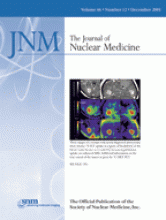Abstract
Transient ischemic dilation (TID) is both a sensitive and a specific indicator of triple-vessel coronary artery disease. This finding, obtained from ungated SPECT images, is the ratio of the average ventricular size after stress compared with rest. With gated SPECT, however, measurements of the end-diastolic volume (EDV) and end-systolic volume (ESV) can be obtained, and the relative contributions of each to the TID ratio may be estimated. The objective of this study was to quantify the relative contributions of the EDV and ESV when correlating an optimized stress-induced volume ratio (SIVR) with myocardial ischemia. Methods: A retrospective review was made of 422 consecutive patients undergoing gated SPECT myocardial perfusion imaging. Semiquantitative summed stress and rest scores were determined using a 17-segment, 5-point model. The presence of myocardial ischemia was defined as a summed difference score of ≥3 (i.e., myocardial ischemia of >4%). Poststress-to-rest ratios of the EDV, ESV, and left ventricular ejection fraction (LVEF) were correlated with myocardial ischemia. Using a brute force method, relative weights were assigned empirically to the EDV and ESV to calculate an optimized SIVR having the strongest correlation with myocardial ischemia. Results: There was a significant correlation between the presence or absence of ischemia and the ESV ratio (P < 0.01), the EDV ratio (P < 0.01), and the LVEF ratio (P < 0.05). When controlling for age, type of stress, and sex, the strongest correlation was with the ESV ratio. The SIVR most strongly correlated with myocardial ischemia was found to be the stress-to-rest ratio of the (ESV × 5.0 + EDV). This SIVR was more strongly correlated with myocardial ischemia than the stress-to-rest ESV ratio, EDV ratio, or LVEF ratio. Conclusion: Compared with either the ESV or the EDV stress-to-rest ratio alone, the combination of both results in a stronger correlation with myocardial ischemia. The contribution of the ESV was found to be 5 times greater than the contribution of the EDV when determining a SIVR most strongly correlated with stress-induced myocardial perfusion defects.
Footnotes
Received May 3, 2005; revision accepted Aug. 23, 2005.
For correspondence or reprints contact: Thomas F. Heston, MD, 740 McKinley Ave., #202, Kellogg, ID 83837.
E-mail: heston{at}nwmolecular.com







